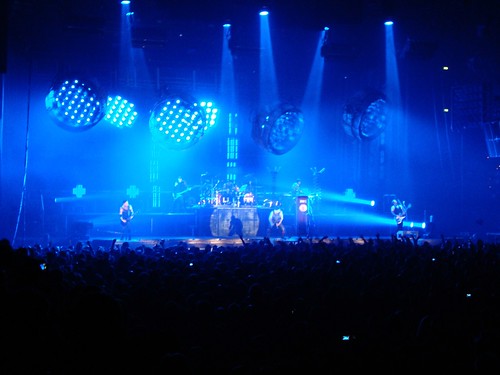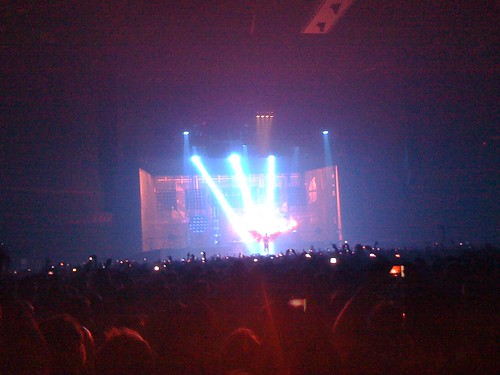I have been to two big gigs lately: "A State of Trance 450" (ASOT) by Armin van Buuren and Rammstein's "Liebe ist für alle da". Going through the process of finding out, buying tickets, getting there, attending and having fun I realised something: There are quiet some differences in promoting, organizing and executing these events. Looking closer it looked like a mirror of the two major ways companies act and communicate today: the classic way (Rammstein) and the new way (van Buuren).
Let me explain you what I mean by comparing these two events...
And this already begins long before the concerts happen when the organizer decide on the
Locations
While a big music band like Rammstein tries to have as many gigs with as many people as possible (they were proud to have around 50 Shows in 12 Countries during the tour 09/10) people like Armin Van Buuren decide on the locations under different circumstances: Rammstein is playing at very big venues in big cities (like the three times they played at the 17k-People-Fitting Wuhlheide in Berlin) while van Buuren played his mini-tour of "A State of Trance 450" (taking place on 5 dates in 4 cities around the globe) in the well known Roseland Ballroom, New York, as well as the 400k people small Bratislava, Slovakia. And as Rammstein is doing this for over 50 concerts world wide it also influences their way to do
Promotion
Rammstein goes to TV-Shows promoting their new Album. And as all big bands they do a tour after releasing a new album. So in the TV-Shows they tell about the show and all their dates are shown. Depending on the budget they also do TV and Print advertisements. For this tour they made banners all over the city for example. There is a big marketing machine behind all this, doing all the marketing for all media, including social media of course (well, their way of social media at least).
Armin van Buuren on the other hand totally concentrates on the internet and social media for promotion: he mentions the tour on the weekly radio show, website and forums. When he does it, it is still work-in-progress. He has the idea and the first date but no place nor actual dates yet. This leads to a lot of rumours in the community and people are always excited to get the newest updates on it: they feel included into an exclusive group although they don't have any influence on it. Van Buuren is not spending a dime on expensive, classic marketing of TV or Print commercials. He doesn't have to, he can fill the halls by talking to people on the internet. Rammstein on the other hand needs advertising. This way of communication is also reflected in their
Line Up
Van Buuren is communicating the acts playing at the various events the same way as everything else: mentioning them in his radio show while they come along. Up to 8 DJs are playing per night and it differs from gig to gig. Already before the event started a full line up with the exact time the DJs are going to play is published. No question about who is playing, when or how long. In the case of Rammstein the pre-band is mentioned before as well, but you don't know when they are starting, how long they are going to play or when Rammstein is going to start or how long it will take exactly. They just don't tell you, although you can guess it quiet good as they have really strict schedule for their
Presentation
Rammstein is basically doing mass production: I would consume to much energy to plan 50 totally different concerts. Instead these concerts are well structured with good care. It is well known when it is smart to play a new song and when to play a classic to have the best customer experience. The same goes for the bonus. Once invented as people wanted more, is it a big part of the "concert procedure" now. The band leaving the stage is calculated. The concert ain't over yet, the audience knows it, everyone knows it. This is pure fake. They just want the audience to show their ecstasy, then they come back and play another couple of songs. And until all classics are played and the light changes significantly no one leaves anyway.
At ASOT this is different. Each gig is different. It ain't a mass product. Each gig has a different line up and different DJs are playing. But as there is a strictly timed, publicly transparent schedule, there is no bonus. Ever. Everyone has his time and this time only. Although this making it really strict it also gives new liberty in creativity: the artist can include classics where ever he wants and the way he wants to, or exclude them at all. It's up to him. He doesn't have to have a couple of classics in the back of his hand because people might request a bonus. People know when it is over because it has a time-stamp on it. The artist can't play longer, people are awaiting the next artist already. It can be so easy. Which brings us directly to the
Stage
Rammstein is well known for their wild stage show with a lot of lights, fireworks and special effects. If you want to get an impression of it take a look into the corresponding Flickr Group. But I want to focus on one certain thing: the centre of the show. Let me show you a couple of picture of Rammstein concerts (featuring the current show):
And now let me show you some pictures of "A State of Trance 405" (all by smoku as he is the only one having photos under the creative commons on flickr):
Can you spot the difference? Yeah, yeah, the later has a laser show, but that ain't what I mean. It is the way the light is used. Let me ask you one question: on the later, can you see the Artist? Or could you at least tell me, where he is (as one could argue, that you are just too far away to spot him)? The Artist is placed at the centre of the stage. Right in the middle. But he is not high lighted. Instead the light goes right into the audience: It highlights the audience. While the focus at Rammstein concert is clearly on the band, the artist/DJ at A State of Trance fades into background, the focus is on the audience. To make this clear:
At a Rammstein concert the band and their work gets celebrated while at ASOT the audience is celebrating and the artist enables them with his work.
This is the mayor difference between them: It is a different relation ship between artist and audience. This relation decided on the way they act and you can see it even in the tiniest parts. And this is why some artists (and companies) feel threatened by the possibilities internet and social media provide while others encourage everyone in using them. This relationship decides every action you do, online as well as offline. Just two more examples:
Tickets
Rammstein's tickets are all designed and niced up. They represent the concert, the work, the band. You buy them online, but - and this where you can see the relationship to the audience perfectly - you can buy them online only. Because they have set up some special conditions around it to control the tickets sales: one person can only buy up to 4 tickets, they are only send to the country the concert is in, you have to give the names of the people attending the concert, blah, blah blah. They are threatened by people reselling the tickets, they are threatened by their audience.
One may argue, that reselling is a problem for band of this size, but I go further and say they just don't trust their audience. You can see that when you take a closer look on the fine-prints of the ticket. It tells you all the things are not allowed to do: no drinks in glasses, no drinks with more than 0.5l, you are not allowed to take pictures (they take away big cameras at the entrance as well), you are not allowed to resell the tickets, only the person written on the ticket is allowed to enter and only if he is able to proof himself with an ID and they even threaten you with charging up to 1000€ if you don't act according to the rules.
Now let's a take look into tickets of ASOT: you buy them online as well, but they offer the webpage in the countries language as well as in English, they ship internationally and ... well.. yeah.. That's it. No other rules, no strings attached. You can take your camera, you can take pictures, do what ever you like. Whatever. They just trust their audience. And as the line up differs from gig to gig and therefore every gig is different there is no way someone could spoil the experience for others. They don't need these rules. They are not threatened by their audience.
Who are you?
So, the question is: Do you trust your audience? Only if you trust them, you can honestly want them to participate. Participate into your forums, at your events, participate in social media. But you need to let them: if you don't trust them and don't allow them to take pictures of your concert, but instead threaten them with a fine of 1000€ none of them will upload the pictures to flickr or videos to youtube (Actually some still do as you can see ;) ). If you want to have success in social media - and I mean real success - trust your audience. People do great things if you just let them. And as they are your fans there is pretty much no reason why they should even want to hurt you.
skip to main |
skip to sidebar
Search
or
About
Archiv
Tagged
15talents
28black
37Signals
6 Wunderkinder
aboutus
ackermann
advertisement
advertising
analysis
analyze
apple
b2b
basics
believe
berlin
big vs small
blogging
blogs
bogeyman
book review
brand
break
ceo
Chamillionaire
change
cheatsheet
citydeal
Clay Shirky
clients
comic
communication
company
corporate
creative
creativity
dailymotion
dilbert
drinks28
early adopters
efficiency
email
email marketing
employees
engange
english
entrepreneur
erfolg
etiquette
events
exercise
experience
facebook
Facebook Advertisement
facebook places
fans
feedback
flattr
flickr
followers
forums
Foursquare
free
funny
geeks
german
good example
google latitude
google wave
Gowalla
gps
gründerszene
himym
hitlerblog
hotel
hotel berlin berlin
iAd
indikator
iPhone
itunes
Jason Fried
jerks
KMU
landscape
lbs
letter
limbic brain
linkedin
Location Based Services
mailchimp
Mark Suster
market
marketers
marketing
marketing manager
measurable
measuring
messure
microblogging
mind
monitoring
music
myspace
networking
noise
online
outsourcing
parties
party
passione
places
politics
posterous
products
profits
publication
quote
rammstein
rules
Schwarze Dose
scvngr
series
Seth Godin
sharing
ShouldIcareAbout
simon sinek
social customers
social media
social networks
social web
spam
speak human
spreading
strategie
strategy
students
studivz
success
swissmiss
taz
teaching
tedtalks
theInsider
timing
tips
tools
top down
traffic
trust
tumblr
tweetphoto
twifficiency
twitpic
twitter
unternehmen
ustream
van buuren
video
viral
viral effect
wikis
wright brothers
wunderlist
xing
youtube






No comments:
Post a Comment